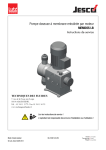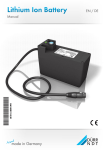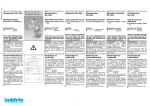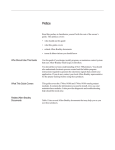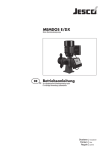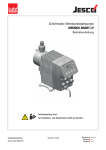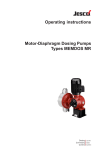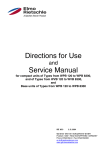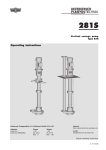Download Operating instructions Motor-Diaphragm Dosing Pumps Types
Transcript
Operating instructions Motor-Diaphragm Dosing Pumps Types MEMDOS E/DX Dosing Conveying Control Liquids Gases Systems Operating instructions MEMDOS E/DX Lutz-Jesco GmbH, 2003 Address: Lutz-Jesco GmbH Am Bostelberge 19 D30900 Wedemark PO Box 10 01 64 D-30891 Wedemark Tel.: +49 (0) 51 30 58 02-0 Fax: +49 (0) 51 30 58 02 6 Représenté par: Rue de la Légende 41 4141 LOUVEIGNE Belgique Tel : +32 4 358 00 12 Fax : +32 4 358 00 14 [email protected] www.hesperia.be 9.03 3 11. Maintenance................................................................................................................. 22-25 11.1 Lubrication...................................................................................................... 22 11.2 Maintenance of bearings ................................................................................ 22 11.3 Replacing the diaphragm........................................................................... 22-23 11.4 Circuit diagram electronic MEMDOS DX................................................... 24-25 12. Explosion-proof dosing pumps........................................................................................ 25 12.1 General .......................................................................................................... 25 12.2 Special conditions .......................................................................................... 25 12.3 Dosing of flammable media............................................................................ 25 13. Spare parts........................................................................................................................ 25 14. Troubleshooting ................................................................................................................ 26 15. Notice d’utilisation en français 16. Certificate of conformity .................................................................................................. 27-29 Hypalon® and Viton® are registered trademarks of DuPont Dow Elastomers Teflon® is a registered trademark of the DuPont Company Hastelloy® is a registered trademark of Haynes International, Inc 9.03 4 1. Safety 1.1 General This Operating Manual contains basic information to be noted during installation, operation and maintenance. It is therefore essential that the Manual be read by the fitter before installing and commissioning the pump/system, as well as by the relevant operating personnel / owner of the pump/ system. It must remain accessible at the pump/ system for reference at all times. In addition to the general safety instructions set out under this main heading Safety, the special safety precautions set out under the other main headings must also be observed, for instance in conjunction with private use. 1.2 Warnings used in this Operating Manual This Operating Manual contains warnings which may endanger persons, the environment and the pump/ system if they are disregarded. These warnings are identified by the hazard symbol safety mark in accordance with DIN 4844-W9 The following symbol is used in conjunction with electric power safety mark in accordance with DIN 4844-W8 The word Caution appears in conjunction with safety instructions which may endanger the machine and its operation if disregarded. Markings which are affixed directly to the pump, such as - Direction of rotation arrow - Markings for fluid connections 9.03 5 - Leakages (e.g. at the shaft seal) of hazardous substances (e.g. explosive, toxic, hot substances) must be discharged in such a way as to exclude all danger to persons and the environment. Statutory regulations must be observed. - Danger due to electric power must be excluded (for further details, refer to the VDE regulations and the regulations of the local public utilities). - Separate regulations must be observed if the dosing pumps are operated in explosion-hazard areas. The explosion hazard must be defined (classification of zones) and appropriate equipment selected by the owner. Further information can be found in section 7.1 (Installation), section 7.5 (Electrical connection) and section 12 (Explosion-proof dosing pumps). 1.7 Safety instructions for inspection, maintenance and installation work The owner must ensure that all maintenance, inspection and installation work is undertaken by authorized and duly qualified skilled personnel who have also studied the Operating Manual in depth. The pump must always have come to a complete stop before starting any work on the pump. The procedure specified in the Operating Manual for shutting down the pump/system must be observed without fail. Pumps or units in contact with potentially harmful media must be decontaminated. All safety mechanisms and guards must be refitted and reactivated as soon as the work is complete. Particular care must be taken when repairing dosing pumps which are used in explosion-hazard areas. Due to the risk of sparking, care must be taken to prevent metal parts or tools knocking against one another. The dosing pump should preferably be moved out of the explosion-hazard area in order to be repaired. The points set out in the section Installation and commissioning must be observed before starting the pump/system. 9.03 1.8 Unauthorized modification and production of spare parts The machine may only be modified or converted in consultation with the manufacturer. Genuine spare parts and accessories authorized by the manufacturer ensure greater safety. Liability for damage or loss may be extinguished if other parts are used. 1.9 Impermissible modes of operation The operational safety of the pump supplied can only be guaranteed when it is used in conformity with its intended use as specified in our contract documents, especially the letter confirming the order. The limit values specified in these documents must never be exceeded. 1.10 Dosing of chemicals - When working on dosing installations, the local safety rules must be observed (e.g. wear personal protective clothes). - Before working on the dosing pump and plant, disconnect it from the mains supply and protect it against reconnection. Before the power supply is switched on again, the dosing lines must be connected so that any chemical left in the dosing head cannot spurt out. - The dosing head of the pump as well as connections and lines of the plant may be under pressure. Working on the dosing plant requires special safety precautions and may only be carried out by instructed technical personnel. - Before startup, all screwed connections must be checked for correct tightness and, if necessary, must be tightened up using appropriate tools. - If connections at the dosing head are unscrewed during operation for venting or other reasons, leaking chemical must be removed professionally. This is the only way to avoid the danger of physical injury and corrosion at the dosing pump. Leaking chemical might also destroy the diaphragm at its mounting points. 6 - When changing the chemical, check whether the materials used for the dosing pump and the other plant parts are chemically resistant. If there is the danger of a chemical reaction between different media, a thorough cleaning first is mandatory. To operate the pump mount the fan shell in order to ensure sufficient cooling of the motor. Protective class of the control unit is only reached if ports are protected by caps or serial plug-in connectors are used. Note Under certain operating conditions, the drive motor of the DX version might warm up considerably. To avoid unintentional contact, provide an appropriate device. Adjustment works in the interior of the ATE drive (optional at MEMDOS E) must be carried out carefully. Connections and internal limit switches might be "alive". - Additional limit switches might be "alive" even with the auxiliary voltage switched off (ATE-drive). - After installation works at the ATE servomotor or before startup remount the cover. 9.03 1.11 Scope of delivery Note Please unpack the dosing pump and ordered accessories carefully in order not to miss small parts. Immediately compare the scope of delivery to the delivery note. If there are any discrepancies, try to find out the reason. For the transportation of the dosing pumps, no special fittings are required. It is, however, advisable to choose a transportation method, which is appropriate for the weight of the dosing pumps (e.g. wagon). During transportation without oil, the dosing pump should be lying. Otherwise it must be tightened to the transportation device. 2. General, purpose The MEMDOS E/DX may only be used in accordance with the specifications in the Technical Data. Local regulations must be observed. Suitable materials must be selected. The operating manual must be consulted for installation, commissioning and maintenance of the dosing pump. Dosing pumps are produced according to highest quality standards and have a long service life. Nevertheless some parts are subject to wear (e.g diaphragm, valve seats, valve balls). To ensure long operating life, visual checks are required regularly. Operating and maintenance personnel must be able to access the pump easily. The MEMDOS E can be operated in explosion-hazard areas of zone 1 if the corresponding drive is taken into account. Further information can be found in the operating manual. Diaphragm dosing pumps from the MEMDOS series are used in industry, in the process engineering sector, as well as in water and wastewater processing. Two models of the MEMDOS E/DX are available: 1. 0...4 bis 0...160 l/h and 2. 0...160 bis 0...380 l/h 7 3. Functional The gear contains a single-stage worm wheel set runing in an oil bath just as the roller bearings. Dosing happens while the push rod is displaced by means of an eccentric. The suction stroke is caused by the resetting of the spring. The stroke length is adjusted by limiting return travel of the poppet using a manually adjustable eccentric as stop. An adjustment range from 0 to 100% is possible. 4.1 Technical data 9.03 8 9.03 9 9.03 10 0 1 2 3 4 5 6 7 8 9 10 Stroke adjustment 0 4 1 2 3 4 5 6 7 8 Stroke adjustment 9 10 2 11 1bar 3bar 5bar 9.03 12 9.03 13 9.03 14 9.03 15 7.2 Installation location Caution Ambient temperatures exceeding 40°C are not permitted. Radiant heat of apparatus and heat exchangers must be shielded so that the dosing pump can still dissipate its own heat sufficiently. Exposure to direct sunlight must be avoided. If the dosing pump is installed outside, provide a roof to protect it against weather. Mount the pump so that the suction and discharge valve are in vertical position. To ensure that the pump stands firm, fasten it with screws on an appropriate foundation. The system piping must not exert any force on the connections and valves of the metering pump. To avoid incorrect metering after the process is finished, provide an electric and hydraulic interlocking system. 7.3 Drain pipe a downward slope - above which the pipe ends at a sufficient distance. Leakage can be returned via the funnel through the tank cover. Besides, possible leakage can be seen at the funnel. Caution If a leakage monitor is installed in the explosionhazard area, the electrical connection must be intrinsically safe. The drive motor must be electrically interlocked to prevent additional medium escaping if a leak occurs. 7.4 Injection fitting assembly Injection fittings are used to mix the metered medium into a main stream and simultaneously fulfil a non-return function. The injection fitting is usually installed in the main line from above. Installation from below is only recommended in the case of media with a tendency to crystallize, in order to ensure that air bubbles are not entrapped. For this type of installation, it is advisable to select a form in which the injection fitting can be sealed off when removed. Caution Drainage or leakage from the separating chamber must be routed with a certain downward slope to the containment tank. By no means must the drain pipe be returned directly to the chemical through the tank cover because otherwise effervescent media might enter the pump gear. The drain pipe may only be routed to a collecting tank free of gases (with a downward slope) or to a collecting funnel - also with 9.03 16 Extractable injection fitting from down below Electrical connection data (other types upon request) Pump size Voltage [Volt] Power [Watt] Current [A] MEMDOS 400/230 50 0.50/0.87 50 0.70 250 0.90/1.55 E4 ... 50 MEMDOS E/DX 4 ... 26 MEMDOS 3~ 50 Hz 230 1~ 50 Hz 400/230 E50 ... 156 MEMDOS E/DX50 ... 156 3~ 50 Hz 230 1~ 50 Hz 120 1.15 400/230 370 1.06/1.84 250 2.25 MEMDOS 7.5 Electrical connection - The electrical connection of the dosing pump must be made according to the local rules and may only be carried out by technical personnel. - Cable type und cable cross section of the supply lines must be selected according to the motor data. - The cable passage to the motor terminal box must be made professionally. We recommend gland screw connections with traction relief. - The required protection class must be ensured by professional installation of the electrical connections. E160 ... 380 3~ 50 Hz MEMDOS E/DX160 ... 380 230 1~ 50 Hz Circuit diagram of the drive motor Caution To avoid early wear of the gear drive adhere to the correct rotation direction of the motor by all means: looking at the fan wheel, counterclockwise. - MEMDOS E Caution - Dosing pumps with explosion-proof motors must be installed and commissioned by specialists qualified to work with equipment destined for use in potentially explosive atmospheres. The user is responsible for ensuring that the explosion-proof motors are connected correctly. - Both the motor and the pump must be grounded to prevent electrostatic discharges. 9.03 17 9.03 18 7.6 Installation example 3 Explanation 4 2 1 2 3 4 5 6 7 8 Dosing pump Suction line Electric agitator Chemical tank Relief valve Diaphragm shutoff valve Injection fitting Pulsation dampener 8. Operating 8.1 Operating panel MEMDOS DX The operating panel has two green LEDs for operation and external control, one red LED for alarm, one 3digit multifunctional display and four keys for settings. The inputs for remote switchoff, low level indication and external control are located below the display. 20 Technical changes are always reserved without notice. 9.03 The functions of the two indicators and built-in fault relay can be seen in the following table: *) LED 2 lights up in operating modes 1.1 - 1.64; 0...20 mA and 4... 20 mA Explanation: 8.5 Factory setting These settings should only be made if the electronic unit is replaced. Max. number of strokes: Keep the keys Mode and I/0 pressed while applying voltage and set the maximum number of pump strokes using keys T and S. After releasing the Mode key, normal operation starts. Alarm relay: If the keys Mode and S bare pressed while applying voltage (display RE0), the relay is currentless in the case of error and OFF, when pressing the keys Mode and T , the relay pulls up in the case of error (display RE1). 9. Stroke length adjustment Caution The stroke length must not be adjusted when the pump is at a standstill ! Proceed as follows to adjust the stroke length: 1. Turn the screw securing the adjusting knob anticlockwise (to the left) to release it. 2. Set the stroke length to the required value in accordance with the delivery characteristics (chapter 5). 3. Retighten the screw without changing the set stroke length. 9.03 10. Start up 1. Before starting the dosing pump all works mentioned in "Installation" (chapter 7) must be carried out. Fill the pump with the oil supplied. At the same time the safety instructions must be observed. 2. The dosing pump MEMDOS E is switched on by a control to be installed externally. The MEMDOS DX has its own control system. Electrical connection and the control system versions are explained in chapter 8, MEMDOS DX operating elements. 3. The manual capacity adjustment must be set to maximum stroke to improve priming. During first priming no backpressure should be applied. For this purpose we recommend to install a relief valve on the discharge side of the dosing pump. 4. A previously installed priming aid must be filled with chemical first. If the pump is not priming, remove the discharge valve and fill water or chemical (if not dangerous!) into the dosing head. Remount valve and start priming. 5. If a venting facility is available as separate unit, open it and wait until liquid escapes. Then close it again. In the case of effervescent liquids allow the liquid to escape permanently (approx. 1 drop for 1...3 strokes). 21 6. When correct operation is achieved, set to required output by means of the adjusting knob (refer to chapter 9) or the electrical remote adjustment. For approximation refer to the performance curves (chapter 5). Depending on the installation and the chemicals used, these values may differ and must be checked under operating conditions. 7. The manufacturer of the metering equipment is not responsible for damages due to excessive or low flow rates resulting from faulty pump settings or incorrect and insufficient installation of peripheral fittings. 10.1 Start up of MEMDOS E with ATE-servomotor Switch on the main drive motor of the metering pump. With an electrical interlocking system, only then can the ATE drive be adjusted. To check the direction of rotation send short control pulses to the ATE servomotor. If the direction of rotation is wrong, the supply lines (terminals 2 and 3 in the case of direct controls) are reversed. The ATE servomotor must be moved to the final positions in order to check the limit stop mechanism of the integrated limit switches. When leaving the factory, the angle of rotation is 270°. If required, the angle of rotation and thus the maximum flow rate can be restricted. To achieve this, the upper trigger cam is shifted by the required value. 11. Maintenance 11.1 Lubrication The diaphragm dosing pump MEMDOS E/DX requires little maintenance. The gear of the pump is lubricated with gear oil of viscosity class ISO-VG 460 according to DIN 51519 (corresponds to SAE 140 according to DIN 51512). The enclosed first filling must be renewed after approximately 500 operating hours. Further oil changes should be carried out every 5,000 operating hours. The filling capacity is about 0.25 l for gears of MEMDOS E/DX up to size 150 and about 0.7 l for gears of MEMDOS E/DX up to size 380. The actually required quantity of gear oil can be determined by checking the min.-max. markings of the oil-measuring stick. 9.03 Caution DX version: To avoid damaging of the approximation initiator, the pump must be switched off before removing the oil gauge. 11.2 Maintenance of bearings The upper bearing of the pinion shaft is a sealed and permanently lubricated ball bearing. This function is simultaneously assumed by the motor bearing on the output side of the size I MEMDOS E/DX pumps (up to E/DX 150). The other rolling bearings in the gearbox and the plain bearings of the diaphragm rod are lubricated by the gear oil. The oil also dissipates the heat generated. All bearings must be examined for wear after 5000 hours of operation. The service life of the rolling bearings depends on the loads to which they are subjected. The bearings must be replaced after 5000 hours of operation if the dosing pump is operated at maximum load. 11.3 Replacing the diaphragm In the case of a rupture the diaphragm can be replaced as follows: 1. The chemical contained in the metering line is drained so that the metering lines become pressureless. Please observe the aforementioned safety instructions for this purpose. 2. The flow rate of the metering pump is set to zero while the motor is running. Thus the diaphragm is moved to its front end position. 3. The head is removed using an appropriate tool. 4. Grasped at the edge, the diaphragm can now be turned out counterclockwise. 5. Before installing the new diaphragm the diaphragm flange section must be cleaned of the chemical. Otherwise the diaphragm might be attacked from the rear side. 6. The new diaphragm is turned in clockwise until it sits close (grease screw thread). 22 Diaphragm-ø 52 64 90 120 150 Torque +/- 10% 125 Ncm 2 Nm 6 Nm 6 Nm 10 Nm 9. After connecting the metering lines, the pump is started as described in chapter 10, startup. 10. If the diaphragm wear is excessively high, try to find out the reason. For this purpose, please refer to chapter 14. Troubleshooting. 9.03 23 24 Technical changes are always reserved without notice. 11.03 External control: Phono jack (cinch) 1 : Middle contact = input (+) brown 2 : Outer contact = 0 (ground) white External control: CSA - variant 3pin plug with cable 1 : Input (+,brown) 2 : 0 (ground, blue) 3 : Not used Protective class of the control unit is only reached if ports are protected by caps or serial plug-in connectors are used. 12. Explosion-proof dosing pumps 12.1 General The MEMDOS E explosion-proof dosing pump is a motor-driven, explosion-proof diaphragm dosing pump of equipment category 2, group II. In combination with an explosion-proof motor (Ex II 2 G E Ex e II T3 or Ex II 2 G E Ex d/de IIB/IIC T4) it is used to meter liquids in potentially explosive areas of zone I. The pump bears the Ex identification ”Ex II 2 G c k T4 03 ATEX D085". Caution The pump must not be used to meter gaseous media or solids. 12.2 Special conditions Compliance with the minimum requirements for the zone classification must be ensured when using the dosing pump in potentially explosive areas. Both the pump itself and the motor must meet with the minimum requirements. 12.3 Dosing of flammable media All metal parts in the intake and delivery piping must be grounded to prevent electrostatic discharges when dosing explosive liquids. Stainless steel is recommended for the dosing head. Dosing pumps with diaphragms measuring more than 90 mm in diameter are equipped with special conductive diaphragms to prevent static charging. Only the original diaphragm may be fitted when ordering replacement parts. 9.03 13. Spare parts Genuine spare parts from Lutz-Jesco must be used. Wear parts for the MEMDOS MR are available as a set of spare parts containing the following: - Pump diaphragm - Valve balls - Valve seats - all valve seals Pump size 4 ... 26 Material dosing head / valves Part No. PVC/PVDF Viton® 29750 29791 33698 29751 28274 28275 28276 PVC/PVDF PTFE PVC/PVDF EPDM 1.4571 PVC PVC 1.4571 PTFE Hypalon® Viton® AF 110 ... 156 PP Hypalon® PP 1.4571 Viton AF 160 ... 260 PP Hypalon® PP 1.4571 Viton® AF 300 ... 380 PP Hypalon® 50 ... 76 PP 1.4571 ® ® Viton AF 28300 28301 28302 28308 28309 28310 28316 28317 28318 25 14. Troubleshooting TYPE OF FAULT POSSIBLE CAUSE RECOMMENDED ACTION Pump not delivering. Valves leaking. Clean and remove air from valves. (See also startup of pump.) Tighten screw connections. Valves incorrectly installed. Reassemble valves. Ensure that the valve balls of suction and discharge valve are located above the valve seats. Suction filter, foot valve or suction pipe leaking or blocked. Clean and seal suction line. No stroke movement. Return spring broken. Replace spring. Consider density of the chemical! Suction lift too high. Pump delivering too little or irregularly. Valves blocked or leaking. Clean and re-seal valves. Pump delivering too much. Pressure on suction side too high (pump siphoning). Install backpressure valve in discharge line. Frequent diaphragm. ruptures. Diaphragm was not screwed into diaphragm rod as far as stop. Screw in new diaphragm as far as stop. Injection nozzle blocked. Clean injection nozzle; fit larger one, if necessary. Pressure peaks because metering line is too long or too narrow. Change line or install pulsation dampener. For increased safety install relief valve (see installation example). Roller bearing defective. Replace roller bearing. No or little oil in gearbox. Refill oil, as described in section "maintenance". Wrong connection. Check electrical wiring. Capacitor defective, wrong size or incorrectly connected. Connect capacitor correctly or replace. Pressure too high. Check process. Low level alarm signaling, Low level main alarm, internal error. Check functions as described in chapter 7 (MEMDOS DX control unit). Pump very noisy. Motor hums and doesn't start. Indication of alarm states by red LEDs near display. If the problem cannot be corrected on the basis of the above data, return the pump to the factory or contact our Techical Sales Service for further measures. Repairs will be carried out immediately 26 15. MEMDOS E/DX NOTICE DE MAINTENANCE ET D'UTILISATION Instructions dès réception Faire attention en ouvrant l'emballage contenant la pompe doseuse, les petits accessoires de celle-ci (raccord, huile, etc.) sont livrés en vrac dans le même carton. Comparer le bon de livraison avec les marchandises réceptionnées et avertir te fournisseur au plus vite de manquements éventuels. Pour te transport, il n'y a pas de recommandation spécifique, les pompes sont livrées sans huile (l'huile est dans un flacon externe). Dans le cas où les pompes sont livrées avec huile, elles doivent être solidement fixées de manière verticale. Données techniques 1) Spécial pour fréquence 60Hz 2) Ne peut pas travailler en 60Hz S 3) Température ambiante : tête PVC (40°C), tête PP ou INOX (60X) et pour court moment 80 C Installation Pour le choix de la pompe ou du local où celle-ci sera installée, il faut respecter les régles en vigueur. Cela s'applique à la sélection du matériel, du mode de transport du liquide et de l'installation électrique. Par ex. d'après le tableau ci-dessus, ne pas oublier de comptabiliser la longueur et te diamètre nominal des tuyauteries pour le choix de la pompe doseuse. Lors de l'installation, l'utilisateur doit s'assurer qu'une fuite de produit ne puisse endommager d'autres accessoires (fuite pouvant être causée par rupture de conduite ou de membrane). Nous recommandons l'installation de sondes de détection de fuite et de bacs de récolte. Les pompes doseuses sont fabriquées d'après des standards de haute qualité et ont une longue espérance de vie, sauf les pièces d'usure normale telles que membranes, billes, joints. Pour s'assurer de la bonne longévité de la pompe, un contrôle régulier est nécessaire. Pour diminuer les risques de casse en fonctionnement anormal, nous recommandons l'utilisation d'accessoires tels que soupape de sécurité, soupape de contre pression, sonde de détection de fuite, sonde de niveau bas et ballons amortisseurs contre les fluctuations de pression. Pour éviter des dommages aux parties plastiques, il ne faut jamais les serrer trop fortement au risque de les casser, L'utilisation de vaseline ou de graisse silicone peut aider au montage / démontage des parties plastiques. Des modifications techniques peuvent être apportées sans notification 26/2 ATTENTION : Il faut respecter la compatibilité du matériel avec le produit dosé. Une température ambiante > 40°C n'est pas autorisée sans ventilation forcée. Un chauffage ou échangeur de chaleur ne peut être installé à proximité pour éviter une surchauffe des pièces plastiques. Une exposition au soleil est à éviter et si la pompe est montée à l'extérieur, il faut prévoir un toit pour sa protéger des rayons solaires et des intempéries. La pompe doit être montée avec les clapets aspiration / refoulement dans un axe vertical. Pour être certain que celle-ci ne bouge pas, il est recommandé de la fixer sur un support. Les conduites ne doivent exercer aucune force sur les raccords. Embout de fuite Toute fuite via embout doit être dirigée vers un bac récolteur ou une tuyauterie d'évacuation ouverte. En aucun cas, il ne peut être raccordé à une conduite fermée venant dune cuve d’aspiration pour éviter des vapeurs de produit vers le réducteur. Connexions électriques Le raccordement électrique doit respecter tes régies locales et être fait par du personnel qualifié. Le type de câble et te diamètre doit être sélectionner en fonction de la fiche technique moteur. Pompe MEMDOS Voltage [Volt] Power [Watt] Intensité [A] 400/230 50 0.50/0.87 50 0.70 250 0.90/1.55 E4 ... 50 MEMDOS E/DX 4 ... 26 MEMDOS 3~ 50 Hz 230 1~ 50 Hz 400/230 E50 ... 156 MEMDOS E/DX50 ... 156 3~ 50 Hz 230 1~ 50 Hz 120 1.15 MEMDOS 400/230 370 1.06/1.84 E160 ... 380 3~ 50 Hz MEMDOS E/DX160 ... 380 230 1~ 50 Hz 250 2.25 Connexion : moteur triphasé normal. Pour éviter d'endommager le réducteur, vérifier que le moteur tourne correctement {te ventilateur doit tourner dans le sens anti-horloger) Connexion du moteur DX avec frein. Des modifications techniques peuvent être apportées sans notification 26/3 - MEMDOS E Securité Lorsqu'on travaille sur un équipement de dosage, il faut observer les règles de sécurité en vigueur. Avant toute intervention, couper l'alimentation électrique et s'assurer que la pompe ne puisse redémarrer sans une intervention humaine. Les connexions hydrauliques sont sous pression , II faut si possible purger la conduite avant toute intervention. Avant le démarrage, vérifier toutes les connexions hydrauliques et électriques et si nécessaire les serrer à nouveau. En cas de retrait des connexions hydrauliques, le produit peut endommager la pompe, il faut immédiatement nettoyer celle-ci pour éviter toute corrosion future ou abîmer la chambre de séparation et/ou les pièces de fixation métalliques. Pour fonctionner correctement, il faut s'assurer que la pompe ait un refroidissement suffisant du moteur. NOTE : il se peut que le modèle DX chauffe considérablement. Dans ce cas, on peut soit installer un ventilateur supplémentaire, soit supprimer le frein (câble noir à déconnecter de la boite à borne et à isoler). Démarrage Avant de démarrer la pompe, il faut avoir respecter toutes tes conditions reprises dans te mode d'installation et de sécurité. La Memdos E est allumée/éteinte via un interrupteur externe, La Memdos DX a un interrupteur interne et une commande ON/OFF externe. Les réglages de la course et de ta fréquence doivent être mis au maximum lors de l'amorçage. Aucune contre pression ne doit être appliquée à la première mise en service. Pour ce faire, nous recommandons l'installation d'une soupape de décharge au refoulement de la pompe. En cas d'utilisation de pot d'aide, il faut le remplir avec le produit à pomper. Si la pompe n'aspire pas, enlever le clapet de refoulement et remplir la tête de pompe avec de l'eau (si l'eau n'est pas dangereuse pour le produit à pomper) puis remonter te clapet et démarrer la pompe. 26/4 Si un évent est installé sur la conduite, laisser celui-ci ouvert jusqu'à ce que le liquide sorte puis refermer celui-ci. En cas de liquide effervescent, ouvrir l’évent un coup tous les trois coups de ta pompe. Lorsque la pompe est amorcée, régler correctement le débit sur la course de la membrane. Unité de contrôle DX Panneau de commande Le panneau a deux Lads vertes pour "opération" et "contrôle externe", un Led rouge pour "alarme", un display "3 digits" multifonctions et quatre touches pour programmation. L'entrée pour le ON/OFF distance, le niveau et la commande externe se trouvent en bas du panneau. ON/OFF La pompe peut être manœuvrée ON/OFF par la touche I/O. Le display affiche alors OFP. Mode opératoire Pour sélectionner le mode, appuyer sur la touche Mode et le display affiche la position où se trouve la pompe (ors peut modifier celle-ci par la flèche haut ou bas en circulant dans le menu). Mode interne INT apparaît sur le display et après avoir relâché la touche mode, la fréquence programmée s'affiche. On la modifie par les flèches Haut/Bas. Mode externe Le display affiche le multiplicateur (1,1..1.84) ou le diviseur (2.1.,64.15 et le Led Externe est ON. 0/4-20mA Signal, Il est possible de choisir te signal en appuyant sur la touche mode et en appliquant la même procédure que pour le choix du Multiplicateur/diviseur en cas d'impulsions. Après relâchement de celle-ci, l'afficheur indique la fréquence correspondant au signal reçu. Le Led externe est ON. En cas de courant excédant 20mA, te display affiche OVL et en cas de courant inférieur à 4mA pour une programmation 4-20mA, le display affiche E-l, allume le Led Alarm et arrête la pompe. 26/5 Alarme La pompe possède un contrôle interne. L'alarme est indiquée sur le display et est transmise à distance via le relais. Pré Alarme niveau bas : le Led alarm clignote, te relais est activé et le display affiche E-L Alarme niveau bas : le Led Alarm est ON, le relais est activé et le display affiche E-L Erreur interne : La pompe possède un contrôle interne qui arrête celle-ci si aucune fréquence n'est donnée deux secondes après avoir démarré le moteur {par ex. contre pression trop haute) ou, si le détecteur de coup ne fonctionne pas (le display affiche E-2) En cas de connexion d'une détection de rupture de membrane, le display affiche E-H. Programmation A faire en cas de remplacement de l'électronique, Nombre de coups maximum : retirer le courant, appuyer simultanément sur les touches Mode et î/O en remettant Se courant puis placer la pompe à son nombre de coups maximum par la flèche Haut. Après relâchement de la touche Mode, la pompe est à nouveau en mode normal. Relais d'alarme : retirer le courant, appuyer simultanément sur les touches Mode et flèche Haut en remettant le courant (île display affiche RED), le relais est hors tension en cas de défaut et OFF, par la flèche Bas, 1e relais sera sous tension en cas de défaut et le display affichera BEI). Maintenance Lubrification ; Les pompes Memdos E/DX requièrent une légère maintenance. Le réducteur est lubrifié avec une huile de viscosité ISO-VG 460 (suivant DIN 51519) correspondant à un type SAE 140 (suivant DIN 51512). Le premier remplissage doit être renouvelé après 500 heures de fonctionnement ; ensuite, une fois toutes les 5000 heures. La capacité est de 0.25 I (jusque E/DX 150) et 0.7 i pour tes autres. La quantité peut être vérifiée par l'indication MIN/MAX sur la jauge. Pour les DX, la pompe doit être à l'arrêt avant de renouveler l'huile. Remplacement de la membrane Vider la conduite pour éliminer la pression. La course de membrane de la pompe est placée sur zéro pendant que le moteur fonctionne Démonter la tête en enlevant les vis de fixation. Dévisser la membrane dans le sens anti-horloger Avant de placer la nouvelle membrane, nettoyer la chambre de toute trace de produit. Visser la nouvelle membrane dans le sens horloger (en ayant mis un peu de graisse silicone sur le filet) Mettre la pompe en service et régler la course au maximum. Arrêter la pompe et remonter la tête à laide des vis Reconnecter les raccordements hydrauliques et démarrer la pompe. 26/7 16. Certificat de conformité EC – Declaration of Conformity We, Lutz-Jesco GmbH Am Bostelberge 19 D – 30900 Wedemark hereby certify that the product described in the following complies with the relevant fundamental safety and sanitary requirements and the EC regulations mentioned below due to the concept and design of the version sold by us. If the product is modified without our consent, this declaration loses its validity. Product description: Diaphragm Dosing Pump Model designation: Minidos A, Memdos TM, Memdos M, Memdos ML, Memdos E, Memdos MR., Memdos GMR Relevant EC regulations: EC Low-Voltage Directive (73/23/EEC) EC Directive Relating to Machinery (89/392/EEC) amended by 93/44/EEC Applied harmonized standards, especially: EN 292 – 1 and EN 292 – 2, Safety of Maschines prEN 809, Pumps and Pump Devices for Liquids, Safety Requirements Date, Signature of Manufacturer: 2003/02/02 ........ ... ........... ..................... Information on the signer: Mr. Lucjan Gogolin, Head of Technical Office This declaration is no assurance of characteristics in the sens of the product liability law. The safety notes in the operating instructions must be observed. 9.03 27 EC – Declaration of Conformity We, Lutz-Jesco GmbH Am Bostelberge 19 D – 30900 Wedemark hereby certify that the product described in the following complies with the relevant fundamental safety and sanitary requirements and the EC regulations mentioned below due to the concept and design of the version sold by us. If the product is modified without our consent, this declaration loses its validity. Product description: Diaphragm Metering Pump Model designation: Memdos DX Relevant EC regulations: EC Low-Voltage Directive (73/23/EEC) EC Directive Relating to Machinery (89/392/EEC) amended by 93/44/EEC EC Electromagnetic Compatibility Directive (89/336/EEC) amended by 93/31/EEC Applied harmonized standards, especially: EN 292 – 1 and EN 292 – 2, Safety of Maschines prEN 809, Pumps and Pump Devices for Liquids, Safety Requirements EN 50081 Parts 1 and 2, EN 50082 Parts 1 and 2, Electromagnetic Compatibility, Emission of Noise and Noise Immunity Date, Signature of Manufacturer: 2003/02/02 . . . .^..^p£..^> ................... Information on the signer: Mr. Lucjan Gogolin, Head of Technical Office This declaration is no assurance of characteristics in the sens of the product liability law. The safety notes in the operating instructions must be observed. 9.03 28 EC – Declaration of Conformity We, Lutz-Jesco GmbH Am Bostelberge 19 D – 30900 Wedemark hereby certify that the product described in the following complies with the relevant fundamental safety and sanitary requirements and the EC regulations mentioned below due to the concept and design of the version sold by us. If the product is modified without our consent, this declaration loses its validity. Product description: Explosion proofed Diaphragm Metering Pump Model designation: Memdos E, Memdos MR Relevant EC regulations: EC Low-Voltage Directive (73/23/EEC) EC Directive Relating to Machinery (98/37/EC) EC Directive for Equipment and protective systems intended for use in potentially explosive atmospheres (94/9/EC) Applied harmonized standards, especially: EN 292–1 and EN 292–2, Safety of Maschines EN 809, Pumps and Pump Devices for Liquids, Safety Requirements EN 13463–1, Non-electrical equipment for potentially explosive atmospheres Information on the signer: Mr. Lucjan Gogolin, Head of Technical Office This declaration is no assurance of characteristics in the sens of the product liability law. The safety notes in the operating instructions must be observed. 9.03 29


































